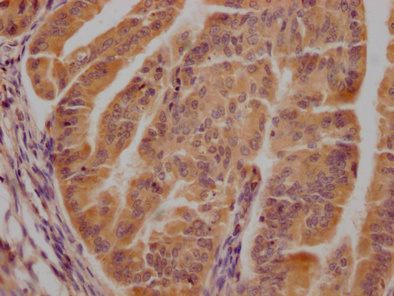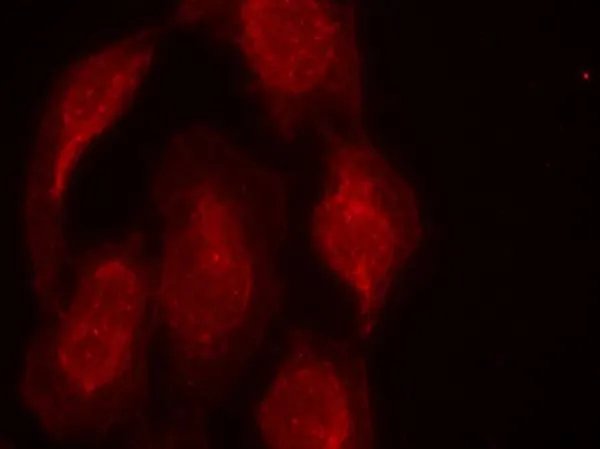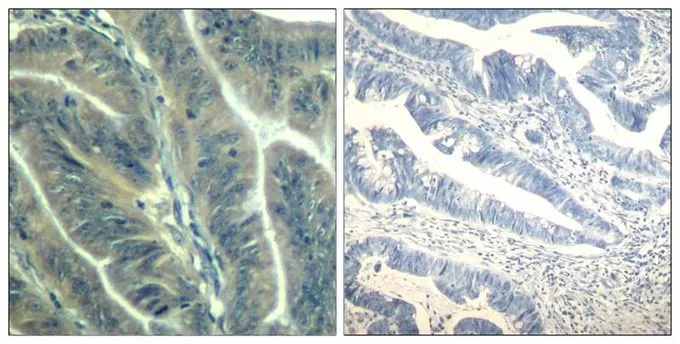CDK6 antibody [N1C3]
GTX103992
ApplicationsImmunoFluorescence, Western Blot, ImmunoCytoChemistry, ImmunoHistoChemistry, ImmunoHistoChemistry Paraffin
Product group Antibodies
TargetCDK6
Overview
- SupplierGeneTex
- Product NameCDK6 antibody [N1C3]
- Delivery Days Customer9
- Application Supplier NoteWB: 1:500-1:3000. ICC/IF: 1:100-1:1000. IHC-P: 1:100-1:1000. *Optimal dilutions/concentrations should be determined by the researcher.Not tested in other applications.
- ApplicationsImmunoFluorescence, Western Blot, ImmunoCytoChemistry, ImmunoHistoChemistry, ImmunoHistoChemistry Paraffin
- CertificationResearch Use Only
- ClonalityPolyclonal
- Concentration1.14 mg/ml
- ConjugateUnconjugated
- Gene ID1021
- Target nameCDK6
- Target descriptioncyclin dependent kinase 6
- Target synonymsMCPH12, PLSTIRE, cyclin-dependent kinase 6, cell division protein kinase 6, serine/threonine-protein kinase PLSTIRE
- HostRabbit
- IsotypeIgG
- Protein IDQ00534
- Protein NameCyclin-dependent kinase 6
- Scientific DescriptionThe protein encoded by this gene is a member of the cyclin-dependent protein kinase (CDK) family. CDK family members are highly similar to the gene products of Saccharomyces cerevisiae cdc28, and Schizosaccharomyces pombe cdc2, and are known to be important regulators of cell cycle progression. This kinase is a catalytic subunit of the protein kinase complex that is important for cell cycle G1 phase progression and G1/S transition. The activity of this kinase first appears in mid-G1 phase, which is controlled by the regulatory subunits including D-type cyclins and members of INK4 family of CDK inhibitors. This kinase, as well as CDK4, has been shown to phosphorylate, and thus regulate the activity of, tumor suppressor protein Rb. [provided by RefSeq]
- Storage Instruction-20°C or -80°C,2°C to 8°C
- UNSPSC12352203
References
- Song L, Tian X, Schekman R. Extracellular vesicles from neurons promote neural induction of stem cells through cyclin D1. J Cell Biol. 2021,220(9). doi: 10.1083/jcb.202101075Read this paper
- Luo CW, Hou MF, Huang CW, et al. The CDK6-c-Jun-Sp1-MMP-2 axis as a biomarker and therapeutic target for triple-negative breast cancer. Am J Cancer Res. 2020,10(12):4325-4341.Read this paper
- Hsin IL, Chou YH, Hung WL, et al. The Application of Arsenic Trioxide in Ameliorating ABT-737 Target Therapy on Uterine Cervical Cancer Cells through Unique Pathways in Cell Death. Cancers (Basel). 2019,12(1). doi: 10.3390/cancers12010108Read this paper
- Yeh HT, Tsai YS, Chen MS, et al. Flavopereirine induces cell cycle arrest and apoptosis via the AKT/p38 MAPK/ERK1/2 signaling pathway in human breast cancer cells. Eur J Pharmacol. 2019,863:172658. doi: 10.1016/j.ejphar.2019.172658Read this paper
- Méndez-Barbero N, Gutierrez-Muñoz C, Madrigal-Matute J, et al. A major role of TWEAK/Fn14 axis as a therapeutic target for post-angioplasty restenosis. EBioMedicine. 2019,46:274-289. doi: 10.1016/j.ebiom.2019.07.072Read this paper
- Fararjeh AS, Chen LC, Ho YS, et al. Proteasome 26S Subunit, non-ATPase 3 (PSMD3) Regulates Breast Cancer by Stabilizing HER2 from Degradation. Cancers (Basel). 2019,11(4). doi: 10.3390/cancers11040527Read this paper
- Ko JL, Lin CH, Chen HC, et al. Effects and mechanisms of betulinic acid on improving EGFR TKI-resistance of lung cancer cells. Environ Toxicol. 2018,33(11):1153-1159. doi: 10.1002/tox.22621Read this paper
- Liu YH, Weng YP, Tsai HY, et al. Aqueous extracts of Paeonia suffruticosa modulates mitochondrial proteostasis by reactive oxygen species-induced endoplasmic reticulum stress in pancreatic cancer cells. Phytomedicine. 2018,46:184-192. doi: 10.1016/j.phymed.2018.03.037Read this paper
- Lu WJ , Wu GJ , Chen RJ , et al. Licochalcone A attenuates glioma cell growth in vitro and in vivo through cell cycle arrest. Food Funct. 2018,9(8):4500-4507. doi: 10.1039/c8fo00728dRead this paper
- Zhang X, Liu D, Li M, et al. Prognostic and therapeutic value of disruptor of telomeric silencing-1-like (DOT1L) expression in patients with ovarian cancer. J Hematol Oncol. 2017,10(1):29. doi: 10.1186/s13045-017-0400-8Read this paper




